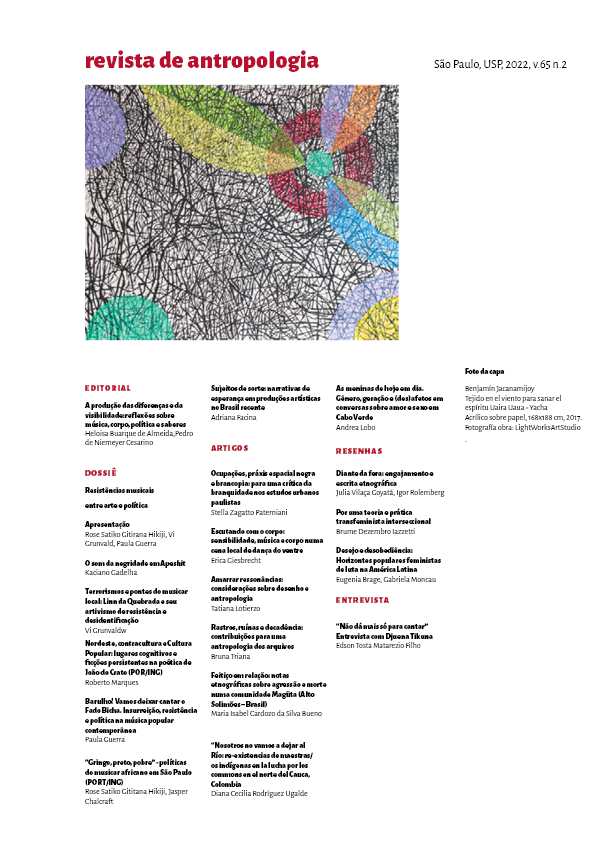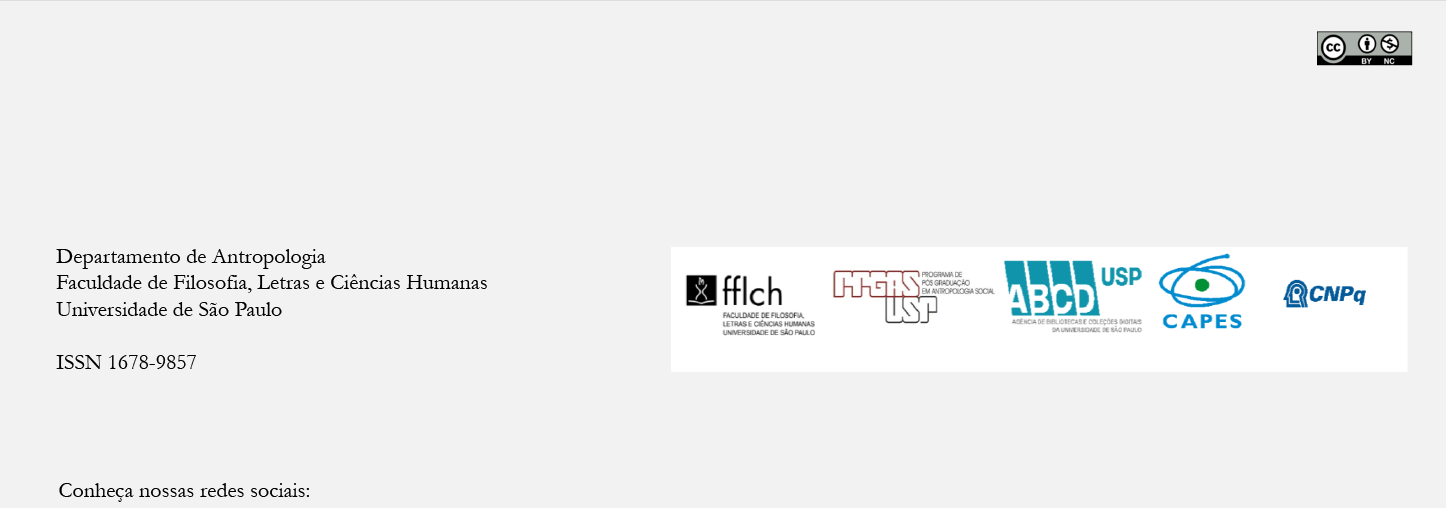Listening with the body: sensitivity, music and body in a local belly dance scene
DOI:
https://doi.org/10.11606/1678-9857.ra.2022.198224Keywords:
Belly dance, ethnomusicology, dance anthropology, sensitivity, embodymentAbstract
In this article, I intend to show the intrinsic relationship between musical perception and body agency developed in the practice of belly dance, using ethnomusicology and anthropology as theoretical instruments. Then, I try to think about how the experience of listening to music in belly dancing, which involves the body as a whole, develops and produces effects among dance practitioners. These reflections are preceded by a brief reflection that situates the bodies involved in a specific scene – the city of São Paulo – demonstrating the extent to which this location particularizes the dance process in comparison to other places in the world where it is disseminated.
Downloads
References
BANASIAK, Krista. 2014. “Dancing the East in the West: Orientalism, feminism, and belly dance”. Critical Race and Whiteness Studies, v. 10, n. 1: 6-24.
BECKER, Judith. 2004. Deep Listeners. Bloomington, Indiana University Press.
BARDET, Marie. 2015. A filosofia da dança: um encontro entre dança e filosofia. São Paulo, Martins Fortes.
BENCARDINI, Patrícia. 2002. Dança do Ventre: Ciência e Arte. São Paulo, Textonovo.
CSORDAS, Thomas. 1990. “Embodiment as a Paradigm for Anthropology”. Ethos, Urbana, v. 18, n. 1: 5-47.
BLACKING, John. 1983. “Movement and Meaning: Dance in Social Anthropological Perspective”. Dance Research: The Journal of the Society for Dance Research, v. 1, n. 1: 89-99.
BLACKING, John. 1985. “Movement, Dance, Music and the Venda girls’ initiation cycle”. In: SPENCE, Paul (org.). Society and the Dance. Cambridge, Cambridge University Press, pp. 64-91.
BOURDIEU, Pierre, PASSERON, Jean Claude. 2013. A reprodução. Elementos para uma teoria do sistema de ensino. São Paulo: Vozes.
BORDELON, Candace. 2011. "Finding the Feeling” Through Movement and Music: An Exploration of Tarab in Oriental Dance. Denton, dissertação de Mestrado, Texas Woman’s University.
CSIKSZENTMIHALYI, Mihaly. 1990. The Body in Flow. In: The Psychology of Optimal Experience. New York: Haper & Row Publishers, pp. 94-116.
CSORDAS, Thomas. 1990. “Embodiment as a Paradigm for Anthropology”. Ethos, Urbana, v. 18, n. 1: 5-47.
DENORA, Tia. 2000. Music in Everyday Life. Cambridge, Cambridge University Press.
DIB, Márcia Camasmie. 2013. Música Árabe, expressividade e sutileza. Edição da autora.
DOWNEY, Dennis; REEL, Justine; SOOHOO, Sonya e ZERBIB, Sandrine. 2010. “Body image in belly dance: integrating alternative norms into collective identity”. Journal of Gender Studies, v. 19, n. 4: 377-393.
DOX, Donnalee. 2006. “Dancing Around Orientalism”. TDR: The Drama Review, v. 50, n. 4: 52-71.
FINNEGAN, Ruth. 1989. The Hidden Musicians: Music-making in an English Town. Cambridge, Cambridge University Press.
FRÜHAUf, Tina. 2009. “Decolonizing Bellydance”. Project Muse, v. 53, n. 3: 22-37.
GROSSBERG, Lawrence. 2002. “Reflections of a disappointed popular music scholar”. In: BEEBE, Roger et al. (orgs.). Rock Over the Edge: Transformations of Popular Music. Durham, Duke University Press, pp. 25-59.
HANNA, Judith Lynne. 1988. Dance, Sex, and Gender: Signs ofldentity, Dominance, DeJiance, and Desire. Chicago, University of Chicago Press.
KEFT-KENNEDY, Virginia. 2013. “1970s belly dance and the ‘how-to’ phenomenon: Feminism, fitness and Orientalism”. In: MCDONALD, Caitlin E. e SELLERS-YOUNG, Barbara (orgs.). Belly Dance Around the World. New Communities, Performance and Identity. Londres, McFarland and Co, pp.23.
KORITZ, Amy. 1997. “Dancing the Orient for England: Maud Allan’s The Vision of Salome”. In: DESMOND, Jane (orgs.). Meaning in Motion: New Cultural Studies of Dance. Durham, Duke University Press, pp. 133-152.
LEPECKI, André. 2012. “Coreo-política e coreo-polícia”. ILHA, v. 13, n. 1: 41-60.
LEPECKI, André. 2013. “Planos de composição: dança, política e movimento”. In: RAPOSO et al. (orgs.) A terra do não-lugar. Diálogos entre antropologia e performance. Florianópolis, Editora UFSC, pp. 109-120.
KRAUSS, Rachel. 2009. “Straddling the sacred and secular: creating a spiritual experience through belly dance”. Sociological Spectrum, v. 29, n. 5: 598-625.
MACMASTER, Neil e LEWIS, Tony. 1998. “Orientalism: From unveiling to hyperveiling”. Journal of European Studies, v. 28, n. 1: 121-135.
MCDONALD, Caitlin; SELLERS-YOUNG, Barbara (orgs.). 2013. Belly Dance Around the World. New Communities, Performance and Identity. Londres: McFarland and Co.
MCDONALD, Caitlin. 2012. Global Moves: Belly Dance as an Extra/Ordinary Space to Explore Social Paradigms in Egypt and Around the World. Londres: Leanpub.
MATTAR, Shalimar. 2017. Círculo Mulher: O Movimento Feminino ao Longo da Vida. Oficina do Livro.
MERLEAU-PONTY. 1999. Fenomenologia da Percepção. São Paulo: Martins Fontes.
MOE, Anderson. 2012. “Beyond the belly: an appraisal of Middle Eastern (aka Belly Dance) as leisure”. Journal of Leisure Research, v. 44, n. 2: 201-233.
RACY, Ali Jihad. 1978. “Arabian Music and the Effects of Commercial Recording”. The World of Music, v. 20, n. 1: 47-58.
REILY, Suzel e BRUCHER, Keith (orgs.). 2018. The Routledge Companion to the Study of Local Musicking. New York, Routledge.
SCHECHNER, Richard. 1985. Between Theater and Anthropology. Philadelphia, University of Pennsylvania Press.
SELLERS-YOUNG, Barbara. 2005. “Body, image, identity: American Tribal Belly Dance”. In: SHAY Anthony e SELLERS-YOUNG, Barbara (orgs.). Belly Dance: Orientalism, Transnationalism, and Harem Fantasy. Costa Mesa, Mazda Publishers, pp. 277-303.
SHAY Anthony e SELLERS-YOUNG, Barbara (orgs.). 2005. Belly Dance: Orientalism, Transnationalism, and Harem Fantasy. Costa Mesa, Mazda Publishers.
SHAY, Anthony. 2008. Dancing Across Borders: The American Fascination with Exotic Dance Forms. Jefferson, McFarland & Company, Inc. Publishers.
SMALL, Christopher. 1998. Musicking: The Meanings of Performing and Listening. Middletown, Wesleyan University Press.
VILLELA, Alice; TONI, Flávia; MUNIAGURRIA, Lorena; GRUNVALD, Vitor. 2019. “O musicar como trilha para a etnomusicologia”. Revista do Instituto de Estudos Brasileiros, v. 73, n. 1: 17-26.
WRIGHT, Jan; DREYFUS, Shoshana. 1998. “Belly Dancing: A Feminist Project?”. Women in Sport and Physical Activity Journal, v. 7, n. 2: 95-114.
WULFF, Helena. 2006. “Experiencing the Ballet Body: Pleasure, Pain, Power”. In: REILY, S. (orgs). The Musical Human: Rethinking John Blacking’s Ethnomusicology in the Twenty-First Century. Aldershot, Ashgate, pp.125-142.
Downloads
Published
Issue
Section
License
Copyright (c) 2022 Revista de Antropologia

This work is licensed under a Creative Commons Attribution 4.0 International License.
Authors who intend to publish in this journal must agree with the following terms:
- a) Authors retain copyright and grant the journal the right of first publication. The work is simultaneously licensed under the Creative Commons Attribution License, which allows the work to be shared as long as the author and the initial publication in this journal are appropriately credited.
- b) Authors are authorized to sign additional contracts for non-exclusive distribution of the version of the work published in this journal (e.g., to publish it as a book chapter), as long as the author and the initial publication in this journal are appropriately credited.
- c) Authors are allowed and encouraged to publish and distribute their work online (e.g. on their personal webpage) after the editorial process, for this can generate productive changes as well as increase the impact and citation of the work. See The Effect of Open Access Publications.




